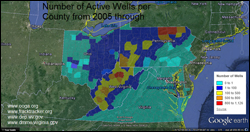Emissions from Natural Gas Wells May Travel Far Downwind
Emissions linked to hydraulic fracturing, the method of drilling for natural gas commonly known as “fracking,” can be detected hundreds of miles away in states that forbid or strictly control the practice, according to a new paper published in the journal Atmospheric Environment. The study, conducted at the University of Maryland (UMD), is among the latest data presented in the ongoing debate over fracking’s long-term effects on the environment. The team used years’ worth of hourly measurements from photochemical assessment monitoring stations (PAMS) in the Baltimore, Md., and Washington, D.C., areas to identify the sources of organic carbons in the region’s air. Starting in 2010, the data didn’t seem to make sense. “While there’s been an overall decline in non-methane organic carbons and improvement in air quality since 1996, the atmospheric concentration of ethane, one of the components of natural gas, rose 30 percent between 2010 and 2013,” says Sheryl Ehrman, professor and chair of UMD’s Department of Chemical and Biomolecular Engineering and the paper’s corresponding author. Methane accounts for 80-95 percent of the makeup of natural gas, and it is thought to have a global warming potential roughly 30 times greater than that of carbon dioxide. However, until recently, monitoring it has not been a priority. Ehrman and her team could not acquire enough long-term methane data for the study, so they instead tracked other “tracer” species (molecules) such as ethane, the second most abundant compound in natural gas, and indicative of emissions associated with natural gas drilling, production, and transport. Preliminary research revealed that there was nothing happening in Maryland that could account for the steep increase. Maryland does not currently permit fracking, but when Ehrman’s team compared the rise in ethane to the extraction of natural gas from the Marcellus shale play in neighboring states, they found a month-to-month correlation. After running a wind rose analysis – a tool used by meteorologists to track the wind direction, distribution and speed in a specified area – they felt even more confident that Maryland was receiving the tail end of emissions originating from Pennsylvania, West Virginia, and Ohio. “Two thirds of the time the Baltimore region was downwind of the Marcellus shale play,” Ehrman says. “The question you start to ask yourself is, if ethane levels are going up this much, and it’s only a small percentage of all natural gas, how much methane and other, more reactive emissions are escaping from these wells?” says Ph.D. student Tim Vinciguerra, the paper’s lead author. “Following the fracturing process, the well undergoes completion venting to clear out fluid and debris before production. A substantial amount of hydrocarbons are emitted as a result of this flowback procedure.” And harmful emissions don’t necessarily have to come from the well to be a byproduct of fracking, he adds. “The diesel engines running the trucks and drilling equipment over long periods of time emit additional pollutants such as nitrogen oxides, particulate matter, sulfur dioxide, and larger hydrocarbons that also affect air quality.” Over the course of the project, Ehrman’s group ruled out other possible sources of ethane that did not produce enough of the gas to explain the change. These included vehicles, natural gas pipeline losses, and natural gas storage fields in Garrett County, Md., located 155 miles away from the area covered by the study. When the team performed the same ethane analysis for Atlanta, Ga., which is located in a region without new and widespread natural gas operations, they did not see the same spike in ethane concentrations. “This study shows the potential contribution of shale gas extraction in Pennsylvania to air quality in downwind states, and the need to consider interstate transport when formulating environmental regulations for particulate matter and ozone control,” says R. Subramanian, a research scientist at Carnegie Mellon University's Center for Atmospheric Particle Studies, whose own research has shown that ethane is a unique marker for methane emissions from the natural gas system. “The strong correlation between Marcellus shale gas production and ethane concentrations in Maryland in particular is a very intriguing result.” “We’ve seen a statistically significant difference in the air quality on the days the wind passed over areas heavy in natural gas production versus the wind coming from areas with no known production,” says Ehrman Group member Alexa Chittams, a Department of Electrical and Computer Engineering sophomore currently performing detailed wind trajectory analyses that could provide quantitative evidence that the ethane in Maryland came from neighboring states. “This suggests that areas of natural gas production contributed to the ethane increase trends.” “What these results mean to me is that we’ve got strong indications that it’s a regional issue,” says Ehrman. “What we want to do is bring this to people’s attention, advocate for long-term methane monitoring, and promote regional cooperation in monitoring and reducing emissions from natural gas production.” These new findings on natural gas emissions also are consistent with established findings by University of Maryland scientists showing westerly winds can carry power plant emissions and other pollution from states like Ohio, West Virginia, and Pennsylvania to the Washington, D.C., region and elsewhere on the East Coast of the U.S. This work was funded by the National Science Foundation, the Maryland Department of the Environment, and NASA. For More Information: Timothy Vinciguerra, Simon Yao, Joseph Dadzie, Alexa Chittams, Thomas Deskins, Sheryl Ehrman, and Russell R. Dickerson. 2015. Regional Air Quality Impacts of Hydraulic Fracturing and Shale Natural Gas Activity: Evidence from Ambient VOC Observations. Atmospheric Environment 110 (April): 144-150. http://dx.doi.org/10.1016/j.atmosenv.2015.03.056
April 30, 2015 Prev Next |


